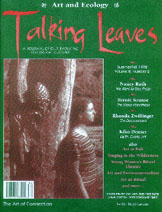Right away, people took me in and I was amazed by their generosity and openness, and the ways in which they live together. I lived with a family of eight, spanning four generations, which is common. The people I knew live in an intricate social structure which insures that everyone has an important role in their family compound, their extended family, and the banjar (a religious neighborhood organization). This sense of community is also experienced on a personal level. People of the same gender are constantly holding hands or have their arms around each other--I even saw two policemen casually hugging in the street. This ease in relating and expressing affection is extended to visitors as well. I found that after a short introduction the people I met would invite me to their homes, help me get places, and even insist on buying me meals. In this way they absorb visitors into their communities. "Whose tourist is that?" is a common Balinese question, expressing the sense of ownership they have of tourists. I had many experiences reaffirming that this ownership reaches beyond economic need and comes from an honest desire to feel connected. As a young woman, I attracted a lot of parental attention, especially from my teachers.
Art in Bali: Creativity and Community
1998 Fall | Kestrel Gates
Additional photographs by Che Jo Last winter I spent three months in Bali, a small island in Indonesia. My original intention in going to Bali was to study dance and other art forms. Quickly, I realized that taking art classes was teaching me much more than art. As I experienced cultural differences, I began to get a glimpse at the relationship between myself, the creative process and the community around me. These perceptions and understandings are ever evolving. By writing them I don't intend to idealize Balinese culture or portray the end-all truth, but to inspire the contemplation of the relationship between creativity and community.
Art as Ritual: The Deep Ecology of Relationship
1998 Fall | Jesse Wolf Hardin (Lone Wolf Circles)
"Culture comes up out of the earth, vibrating through the body, as each individual affirms life and expresses her or his unique creativity. It is kept alive by consciously honoring the sacredness of the four Great Mysteries: food, sex, birth, and death. The ceremonial arts are channels for people to express their relationship with these primal mysteries." - Sedonia Cahill
While we may hesitate to call it worship, it is more than adoration that fosters the heights of our art. It is an acknowledging and glorifying of the inner essence of the subject, the numinous essence that our creations can, at best, only allude to. It is the connection of Vision to the visible, Spirit to the physical, fostered by our own loving hands, the mixing on the palette of pain and joy, struggle and hope.
Art and Ecology: v08 n02 Talking Leaves Magazine Fall 1998
1998 Fall
Summer/Fall 1998
Volume 8, Number 2
Art and Ecology
CONTENTS
* "Introduction to This Issue" by Chris Roth
Section One: The Art of Connection
* "Earth, Ovens, Art" by Kiko Denzer
* "We Want to Stay Frogs" by Nancy Roth
* "A Long Night's Journey into Day" by Chris Roth
* "Singing in the Wilderness" by Jules Bubacz
* "Art in Bali" by Kestrel Gates
* "Dance, Theatre, Community, Life" by Hannah Fox
Section Two: Art as Environmental Statement
Volume 8, Number 2
Art and Ecology
CONTENTS
* "Introduction to This Issue" by Chris Roth
Section One: The Art of Connection
* "Earth, Ovens, Art" by Kiko Denzer
* "We Want to Stay Frogs" by Nancy Roth
* "A Long Night's Journey into Day" by Chris Roth
* "Singing in the Wilderness" by Jules Bubacz
* "Art in Bali" by Kestrel Gates
* "Dance, Theatre, Community, Life" by Hannah Fox
Section Two: Art as Environmental Statement
First Content
This is the first content of the web site from its developer. This is to get things rolling and get thet default page off of the front page.
